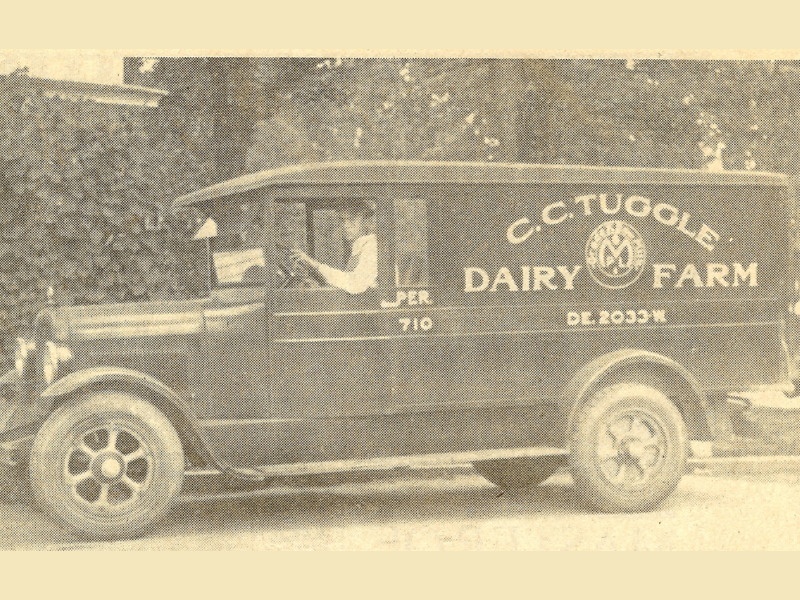No Cattle Left at the Ranch (Home): DeKalb’s Dairies to Homes
Read on to learn about DeKalb County’s transformation from dairy pastures to Georgia’s fourth most populated county in less than a century.
By Kathryn Turnbull, Archives Assistant
What stories are buried beneath your apartment complex, neighborhood grocery store, or your children’s school? Take, for example, the intersection of Briarcliff and North Druid Hills Roads; the place where a young Joe Greear once watched a man “steering a mule-driven wagon” towards the historic Mount Moriah community. (1) At the same intersection today, commuters struggle through gridlock, surrounded by dozens of chain restaurants, shops, gas stations, and office parks. This same intersection is within a stone’s throw of the original site of the Tullie Smith House, ca. 1845, which was relocated by the Atlanta History Center in 1969 in order to ensure the home would survive DeKalb’s rapid development. (2) Greear’s map of the Briarcliff of his childhood, circa 1960, is almost unrecognizable today:
DeKalb County was radically transformed during the second half of the twentieth century as dairy farms were subdivided and expressways were carved into dense forests. Long before the Brighten Park shopping center existed, the Tuggle family operated a large dairy farm at 2534 Briarcliff Road. Founded in 1885, the dairy “sold 18,000 gallons of milk daily to some 3,000 customers” at its peak. (3) After being leased to Pet Dairy Company in 1960, the old farm gave way to development and was sold in 1983. Third-generation Ralph Tuggle believed “there were once a dozen dairies” on and around Briarcliff Road in North DeKalb. (4) It’s hard to picture a dozen such farms, with pasture-raised cows and fleets of delivery trucks, situated on busy Briarcliff Road today.
Figure 1: Ralph Tuggle “at about age 15, he guesses,” driving a delivery truck, “probably a 1924 model.” (5)
The Tuggle’s operation in North DeKalb wasn’t an anomaly; in fact, the county was dominated by dairy farms for generations. In the 1930s, DeKalb boasted “more cows than any county outside the state of Wisconsin.” (6) Some dairy farmers estimated there were between 200 and 240 independent dairies during the Great Depression. How is that possible? The county’s claim to fame began prior to World War II, when “all undeveloped land in the county was zoned for dairy farming.” (7) Proximity to the large and growing Atlanta market, coupled with an abundance of cheap land and lack of strict regulation before pasteurization was mandated in 1943, made dairy farming a popular survival strategy, especially for those left destitute by the boll weevil (8). In 1936, “there wasn’t much else we could do,” according to Henry Milton Sheppard of the bygone Sheppard Brothers Dairy in Stone Mountain. (9) After nearly 60 years in operation, Sheppard Brothers sold their “last two gallons of whole milk” to drive-up customers in 1995. (10)
As DeKalb’s population tripled in size between 1945 and 1970, developers built nearly 1,300 subdivisions throughout the county to accommodate the growth. (11) These midcentury subdivisions were completed by dozens of unique developers building just a few streets at a time, creating a distinctive suburban geography. This moment gave rise to the prevalence of the Ranch home, the style and construction of which “was well adapted to DeKalb County’s climate, topography, and cultural attitudes.” (12) But as property values in Metro Atlanta took off, “any greenspace that remained after development was simply land not suitable as building space.” (13) Thus, DeKalb’s once-famous acres of open dairy farmland were chopped up into thousands of parcels after the end of World War II, and, ironically, the cows had no place at the modern Ranch.
Operations at W. O. Pierce Dairy, “Atlanta’s Milk Supreme,” on North Peachtree Road between Chamblee and Doraville (14)
DeKalb’s transformation from dairy pastures to Georgia’s fourth most populated county in less than a century demonstrates the power of Atlanta’s urban sprawl. Spurred by myriad factors including the Baby Boom and white flight, farmland quickly became subdivisions, office parks, and shopping malls. While Joe Greear’s “house in the woods” and the Tuggle Dairy operation may be long gone, our records preserve the traces they left behind. If you’re curious about this era in the county’s not-so-distant past, check out our digitized Subject Files, or consider making an appointment with our Archivist for more specific research requests.
- Joe Greear, “Growing Up On the Edges,” p. 16, DHC Collections
- Claire Haley, Atlanta History Center
- Letter from Janice Tuggle Massee and the Atlanta Journal, June 10, 1960 (Subject File: Agriculture-Dairy Farms: C. C. Tuggle Dairy Farm)
- Atlanta Journal, June 10, 1960 (Subject File: Agriculture-Dairy Farms: C. C. Tuggle Dairy Farm)
- DHC Collections
- Charles Watson, “Where the kids met the cow,” Atlanta Journal Constitution, February 9, 1996 (Subject File: Agriculture-Dairy Farms: R. L. Mathis Dairy
- Burton et. al., “Single-Family Residential Development: DeKalb County, Georgia 1945-1970,” Georgia State University Heritage Preservation Graduate Studies Program, 2010, p. 22 (Subject File: Architecture: Single Family Residential Development”)
- New Georgia Encyclopedia; Dairies in DeKalb Exhibit, DeKalb History Center
- B.C. Fogel, “Days Could Be Numbered for DeKalb’s Only Producing Dairy,” Neighbor Newspapers, September 11, 1985 (Subject File: Agriculture-Dairy Farms: Sheppard Brothers Dairy)
- Ben Smith III, “Dairy squeezed out: Urban sprawl puts an end to Atlanta’s last milk producing farm,” Atlanta Journal Constitution, September 16 1995 (Subject File: Agriculture-Dairy Farms: Sheppard Brothers Dairy)
- Burton et. al., 89
- Burton et. al., 71
- Burton et. al., 88
- DHC Collections









